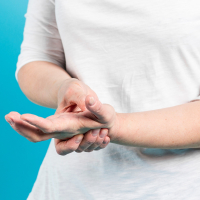
Surgery or non-surgical treatment: which works better for carpal tunnel syndrome?
Key messages
Surgery probably results in a higher rate of clinical improvement than splinting after a follow-up of 6 to 12 months. The evidence on which of the two treatments may have less harmful effects is uncertain.
The evidence is uncertain if clinical improvement or the rate of harmful effects differ between surgery and corticosteroid injection after a follow-up of 6 to 12 months.
Generally, we lack confidence about the efficacy of surgery in people with carpal tunnel syndrome because we did not find studies comparing surgery with placebo surgery or no treatment. Future studies should address this evidence gap.
What is carpal tunnel syndrome?
Carpal tunnel syndrome is a condition in which the median nerve at the wrist is compressed, causing numbness, tingling in the thumb, index and middle finger, and pain. In severe cases, skin sensation can be permanently diminished and compression may cause muscle wasting at the base of the thumb.
How is carpal tunnel syndrome treated?
Usually, non-surgical treatments such as splints, corticosteroid injections, exercises and manual therapy are offered as first-line treatments. Surgery is considered for people with persisting symptoms and sometimes as the primary treatment for people with severe symptoms.
What did we want to find out?
If surgery or non-surgical treatment is more beneficial and less harmful for treating carpal tunnel syndrome.
What did we do?
We searched for studies that compared surgery with 1) no treatment or placebo treatment, or 2) any non-surgical treatment. We compared the rate of clinical improvement, symptoms, hand function, pain and health-related quality of life, as well as harmful effects and need for further surgery. We collected and analysed data according to Cochrane methods.
What did we find?
We found 14 studies randomising 1231 people: mean age ranged between 32 and 53 years; 84% female; representing nine countries from Asia, Europe and North America; symptom duration 31 weeks to 3.5 years with a varying degree of severity. Surgery was compared with 1) splinting, 2) corticosteroid injection, 3) splinting and corticosteroid injection, 4) platelet-rich plasma injection, 5) manual therapy (three 30-minute treatment sessions including desensitisation manoeuvres, once per week), 6) multimodal non-operative treatment (combination of six visits of hand therapy, activity modification, nonsteroidal anti-inflammatory drugs, splinting, followed by ultrasound treatment if needed), 7) unspecified medical treatment and hand support. Additionally, one study compared corticosteroid injection with surgery plus corticosteroid injection. Two studies reported including people who had been unresponsive to at least 2 weeks of non-surgical treatment. Study sizes varied from 22 to 176 people. Ten studies measured outcomes at long-term follow-up (over 3 months, usually 6 or 12 months).
We did not find studies comparing surgery with placebo surgery or no treatment.
Key results
Because surgery is often used for its long-term effects, this summary focusses on long-term follow-up (6 to 12 months).
Surgery compared to splinting
Surgery probably results in a higher rate (twice) of clinical improvement compared with splinting. However, surgery may not be more beneficial than splinting for improving symptoms or hand function, or general health-related quality of life.
We are uncertain if the risk of harmful effects differs between surgery and splinting. Some people in the splinting group had surgery-related harms because they had undergone surgery before the outcomes were measured. However, surgery probably reduces the need for further surgery.
Surgery compared to corticosteroid injection
We are uncertain if clinical improvement, symptom relief, risk of harmful effects and the need for further surgery differ between surgery and corticosteroid injection. Hand function or pain probably do not differ considerably.
Other comparisons
Surgery is probably slightly more beneficial than multimodal non-operative treatment for improving symptoms, but may not provide benefits for other outcomes.
Surgery probably results in a higher rate of clinical improvement than manual therapy (1.6 times) but may not provide benefits for other outcomes.
We are uncertain if surgery provides more benefits compared with a combination of splint and corticosteroid injection.
What are the limitations of the evidence?
The most important limitation is that there is no existing evidence to determine whether surgery is better than no treatment or if surgery is more effective than continuing non-surgical treatments for people who have not improved with non-surgical interventions. Additionally, it is unclear if surgery could provide more long-lasting effects after several years' follow-up.
Our confidence in the evidence regarding the differences between surgery and non-surgical treatment was mostly affected by the fact that people in all the studies were aware of which treatment they received. This may affect how people report the outcomes and result in biased estimations of treatment effects. Furthermore, in two large studies, up to 40% of people, who were randomised to non-surgical treatment, opted for surgery during the study and had already undergone it by the time long-term outcomes were measured. If these people had not had surgery, their outcomes might have been worse, with the resulting benefits of surgery being underestimated.
How up-to-date is this evidence?
The evidence is up-to-date until November 2022.

